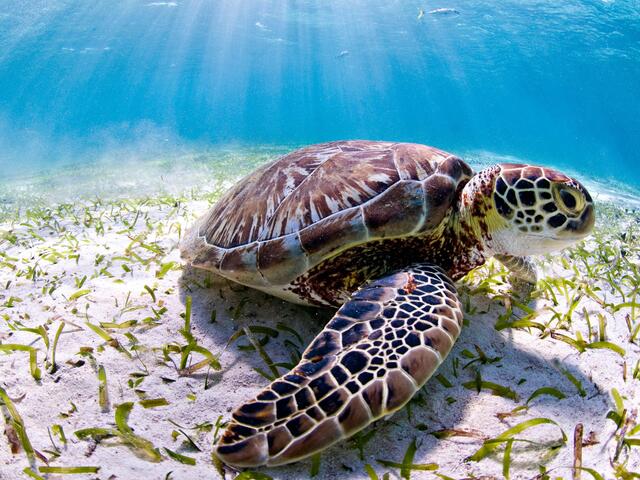Is it true that turtles are reptiles? Learn about turtle classification within the animal kingdom and discover the mysteries that surround these fascinating creatures. Find out more about their unique characteristics and ancient ancestry.
What are Turtles?
A turtle’s unique appearance and fascinating behavior have long captivated human fascination. turtle, (order Testudines), any reptile with a body encased in a bony shell, including tortoises. Although numerous animals, from invertebrates to mammals, have evolved shells, none has an architecture like that of turtles. The turtle shell has a top (carapace) and a bottom (plastron).
Habitats of Turtles
There is no doubt that turtles have successfully colonized a wide range of environments, demonstrating remarkable adaptability. The turtle calls a variety of habitats home. Let’s explore some of them.
1. Freshwater Habitats
There are several types of turtles that live in freshwater ecosystems such as lakes, ponds, rivers, and wetlands, such as the red-eared slider and painted turtle. This type of habitat provides a variety of food sources to the aquatic reptiles, as well as a suitable nesting site for them.
2. Terrestrial Habitats
Box turtles and Russian tortoises, among other turtle species, are primarily terrestrial creatures. Their ability to adapt to a variety of environmental conditions demonstrates their versatility as land-dwelling turtles.
3. Marine Habitats
Turtles spend most of their lives in marine habitats; they are the oceanic adventurers of their species. A large number of majestic reptiles live in the ocean, from leatherbacks to loggerheads, and only return to land to nest.
Unique Features of Reptiles
- Scales: There are many species of reptiles that have distinctive scales, including turtles. The scaly skin of sea turtles protects them against the elements and lurking predators, from the smallest hatchling to the mighty sea turtle. Like a stylish suit of armor, it covers them from head to toe.
- Ectothermy: A turtle does not sweat the small stuff, and I mean that literally! A turtle is not a warm-blooded creature that can maintain a constant body temperature. Turtles are a cooler type of creature when it comes to maintaining a constant body temperature. They warm themselves up by absorbing the sun’s rays and find shade to cool down by absorbing external sources of heat.
- Amniotic Eggs: Turtles lay amniotic eggs in the same manner as their reptilian cousins. It should be noted that these are not your ordinary eggs. They are equipped with an amniotic membrane that nurtures and protects the developing embryo. There is no doubt that the mobile nursery will ensure that the next generation of shelled wonders will survive.
Behavior and Adaptations of Turtles

There is a wide range of behaviors and adaptations exhibited by turtles that contribute to their survival in diverse habitats. Taking a closer look at their behavior will reveal some fascinating aspects.
1. Nesting and Migration
There are many turtle species that exhibit remarkable nesting and migration behavior. Turtle females often lay their eggs on the same beach or nesting site where they were born.
The journeys undertaken by some sea turtles to reach their preferred nesting grounds can encompass thousands of miles.
2. Longevity and Slow Metabolism
There is no doubt that turtles have an exceptional lifespan. They are capable of living for decades, or even centuries, as they have significantly slower metabolic rates than warm-blooded animals.
One of the longest-living turtles is the Galápagos tortoise, which has lived in the Galapagos Islands for more than 100 years.
3. Aquatic Adaptations
Turtles that live in water have evolved remarkable adaptations to survive in the aquatic environment. They are characterized by streamlined shells, webbed feet or flippers, and strong limbs that permit them to move swiftly and agilely through aquatic environments.
It is even possible for some turtle species to possess special glands that allow them to expel excess salt, making it possible for them to reside in both saltwater and freshwater environments.
Must Read: What is Female Betta Fish? Caring for Female Betta Fish
FAQ`s
1. Are turtles considered reptiles?
Reptiles, including turtles, are classified as reptiles. The species resembles several other species of reptiles and belongs to the reptile class.
2. Do all turtles have shells?
The answer is yes, all turtles have shells. These reptiles are characterized by their shells, which are essential protection devices.
3. Can turtles live both in water and on land?
Turtles that live primarily in water are known as aquatic turtles. They use the beach primarily to warm themselves and lay eggs. There are some turtles that spend almost all of their time on land (terrestrials). Take a closer look at some of the characteristics of these turtles. The shells and flippers of swimming turtles are flatter than those of land turtles.
4. Are turtles social animals?
A number of turtle species are known to exhibit solitary behavior; however, others exhibit social behavior. A large number of sea turtles may gather at nesting sites during certain times of the year.
5. Are turtles endangered?
There are indeed many turtle species that are threatened because of habitat loss, pollution, illegal wildlife trade, and climate change. The protection of these remarkable reptiles depends upon conservation efforts.
Conclusion:
Turtles undoubtedly belong to the reptile family. They are classified as reptiles due to their unique characteristics, such as the scaly skin, the ectothermic nature, the amniotic eggs, and the terrestrial adaptations they possess.
The turtle has succeeded in colonizing a variety of habitats, including freshwater ecosystems, terrestrial environments, and vast oceans. It is interesting to study and admire their shells, longevity, remarkable behaviors, and intriguing adaptations that make them intriguing creatures to study.





